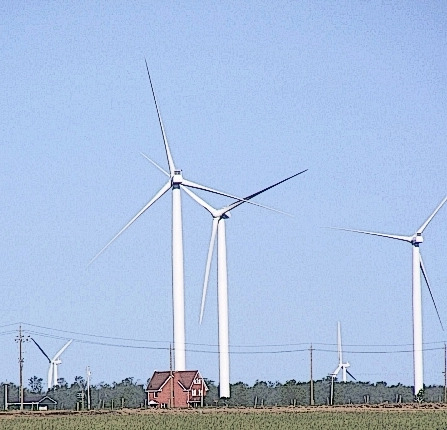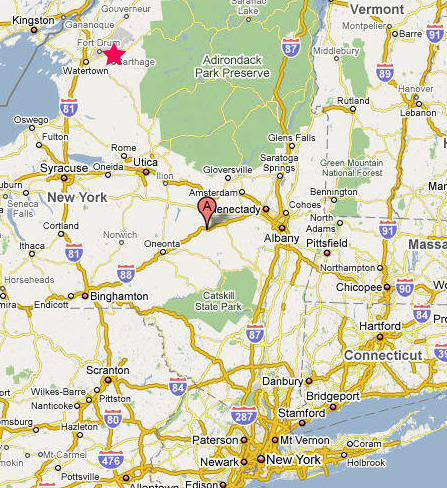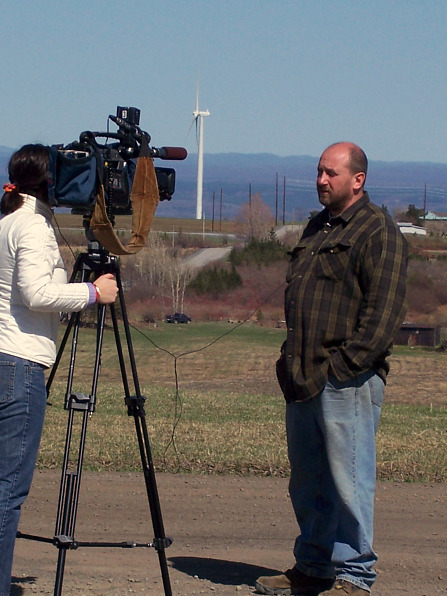5/22/09 It's not all in your head: Wind Turbine Setback Committee confirms what wind farm residents have known all along.
“No resident should have to live under such conditions”: Wind Turbine Setback Committee Report (Richmondville NY)
[SOURCE -This article was originally posted on windturbinesyndrom.com on 5/21/09]

Photo of Ripley (Ontario), much like the Tug Hill Plateau, NY
“After lunch we met with Rick Beyer, an outspoken opponent of the wind farm, whose residence is among the towers. He originally signed on as a participant, but quickly changed his mind after suffering the effects of the noise.
“Roy Bilby was particularly interested in the reports about the low frequency noise being accentuated inside residences, and asked Mr. Beyer if he would mind if we went inside his house to experience the noise. He agreed and, once inside, we all concurred that no resident should have to live under such conditions”(from the Report 5-14-09).
Windturbinesyndrom.com Editor’s note. On April 28, 2009, the Wind Turbine Setback Committee for the Town of Richmondville (NY) visited the Tug Hill (NY) wind turbines, built, as they all are, among the homes of Tug Hill.
Committee members had heard and readstories (on websites like this one) of people suffering from turbine noiseand vibration, and shadow flicker. They wanted to “see for themselves,” to borrow the phrase used by wind developers who likewise invite people to visit an operating wind farm.
The difference this time is that the trip had not been arranged by a wind developer; committee members thus knew that no adjustments had been made to the turbines in anticipation of their visit. Second, the weather unexpectedly changed from being a bright sunny and calm day to a windy rainy day. The wind direction abruptly changed to a direction conducive to noise & vibration. Then things got interesting.
The following is the full report of that informativeexperience, presented by the committee to the Richmondville town board on May 14, 2009. Click here for a copy of the original report, which has been lightly edited, below, for typos, grammar, and clarification.
Wind Turbine Setback Committee Report to the Richmondville (NY)Town Board
·
May 14, 2009
In March 2009 the Richmondville (NY) Town Board charged the Wind Turbine Setback Committee to revisit the setback issue in order to ascertain whether or not there had been any new developments that might alter the original setback recommendations.
Only four of the original seven-member committee were willing to study the matter again, Roy Bilby, William Lancaster, Robert Reed, and Joan Sondergaard.

Richmondville (red teardrop, A). Tug Hill Plateau (red star)
At the first meeting of the committee, Roy Bilby voiced a desire to re-visit the Tug Hill (NY) wind farm once again in order to most definitely confirm the validity of the noise complaints that had been made in many reports and from multiple sources. The rest of the committee concurred, and it was decided that Bill Lancaster would do some research with individuals living in the area as to what weather conditions would demonstrate the legitimacy of the complaints.
It was deemed that the weather forecast for Tuesday, April 28th, looked good, and the trip was planned. Due to the short notice, Bob Reed was unable to make the trip, but the remaining three members decided to go.
The three members arrived at the wind farm at approximately 9AM and spent about one and1/4 hours traveling through the maze of roads that intertwine between the wind towers. Repeated stops were made where we stopped the car, shut off the engine, and got out of the car to listen to the turbines from multiple vantage points, distances, and groupings of the turbines.
When we first arrived, there was a fairly light to moderate wind blowing from the SE and the sun was shining. Around 11:30AM, while talking to Gordon Yancey, a tavern owner [Flatrock Inn] who supports Green Power but has been very vocal against the siting of turbines too close to residential areas, the wind direction changed to North/Northwest with the arrival of a weather front, and it started to rain.

Gordon Yancey, proprietor of the Flatrock Inn, Tug Hill Plateau (NY)
»Sound«
(Note: Two Residents stated that it was too bad that we weren’t there when the sound was loudest. One stated that on a scale of 1 to 1 0 for sound, that particular day was a 4.)
The large blades on the turbines definitely generated sound, which fluctuated between quiet, to quite loud when standing at the same location and depending on the velocity of the wind, which fluctuated continually in short periods of time. The reported “whoosh” to a “thumping” was witnessed by all of us throughout the day.
We verified that the sound was often greater the farther away from the tower we moved, as had been reported by others in the literature. Roy stood directly under the tower, and as he walked back to where we were, he stated that the sound definitely grew louder. Later, when standing at one spot, we found that the noise generated by towers about 1500 feet to 2000 feet was much louder than the one just over 1000 feet.
One of the most disturbing phenomena was the sound resulting from multiple towers, producing sound out of synchrony, which was very definitely annoying.
We also heard mechanical noise emanating from several towers that obviously needed repair, and observed that some were either under repair or having routine maintenance.
We had read about complaints of the different sounds emanating from turbines, but had never heard any complaints about the whistling sounds that we witnessed on Tug Hill. The blades of a few made annoying whistling sounds that could be heard at some distance.
Gordon Yancey’s explanation was that the noise is a result of the tips of the blades developing pits and fissures, which cause a change in the aerodynamics of the blade tips passing through the air. The sound [that is] produced results in a whistling sound.
Regardless of the validity of his explanation, this is definitely an added annoyance factor that we had not previously considered. He also stated that most of the turbine blades were being replaced totally or being replaced with new metal tips to remedy the problem.
After lunch we met with Rick Beyer, an outspoken opponent of the wind farm, whose residence is among the towers. He originally signed on as a participant, but quickly changed his mind after suffering the effects of the noise.
Roy Bilby was particularly interested in the reports about the low frequency noise being accentuated inside residences, and asked Mr. Beyer if he would mind if we went inside his house to experience the noise. He agreed and, once inside, we all concurred that no resident should have to live under such conditions.
Mr.Beyer stated that in the winter, when the ice and frozen snow stick to the blades, the noise is multiplied to [such] a degree that it is impossible to hear yourself think. This can last for weeks at a time in the winter. In addition, wet and foggy, damp weather also greatly enhance the noise throughout the year.
Finally, our committee observed that the Tug Hill terrain, a twelve-mile plateau on which the wind farm is situated, is drastically different from the rolling hills and valleys of the Town of Richmondville. The wind industry itself admits that rolling hills and valleys enhance sound generated by wind turbines and, therefore, increased setback distances must be taken into consideration when siting turbines.
»Acid Rain?«
We all noticed brownish stains, below the nacelles, on many of the towers. Joan questioned Gordon Yancy about the stains that we were observing, and if they were a result of the acid rain in the area. He replied that the stains were a result of the leaking of lubricating oils and the antifreeze used in the nacelles.
He stated, “We were told that the nacelles never leaked oil, but if you look at most of the towers, they all have the leaks which are being dispersed against the towers by the fanning of the blades.” Again, we realized that Gordon Yancey is not an advocate for siting these towers too close to residences, but we did feel that this was some important additional information to explore if necessary.
»Radio and Television Interference«
While in Rick Beyer’s home, he told us about the effect the wind turbines had on his TV reception. One minute the picture would be fine, but as a blade passed through the transmission field, the picture would be like a snowfield passing over the screen. Gordon Yancey made the same comments as to the reception at his place of business.
Rick Beyer stated that he is forced to close his curtains because the reflection of the turning blades on the screen coming through the window is like a continual moving mirror in his living room. His son is unable to use his computer without closing heavy curtains to block out the whirling reflection. Mr. Beyer stated that the company offered to mitigate the problem by buying him some new curtains.
While working in his garage, Mr. Beyer can no longer listen to his radio because it fades in and out, as he demonstrated to us, due to the turbine interference. Monthly complaints io the company, which has assured him that they would mitigate the problems, have resulted in nothing being done in over two years.
»Flicker«
While the sun was shining in the morning, we were able witness the flicker effect the large blades made when reflecting off the surrounding wooded areas and also on the open pastures. This took place at a time when the sun was south of overhead, due to the fact that it was still April. We were not there at sunset or sunrise, when the most bothersome effects are purported to be the greatest, due to the angle of the shadows.
»Other Considerations«
Since our original recommendations, made in the fall of 2008, there has been a trend toward increased setbacks, both in the US and in Europe, and a call for more research concerning the public health effects of wind farm siting.
»Setback Committee Recommendation«
As a result of our visit to Tug Hill and discussion at the wrap-up meeting of the Committee, attended by all four members, it was the unanimous decision of the Committee Members to recommend a setback of no closer than 2500′ from the property line, with the sound requirements remaining the same as in the original recommendations made last fall.
Respectfully Submitted,
Roy Bilby
William Lancaster
Joan Sondergaard
Robert Reed
Members of the Richmondville (NY)Wind Turbine Setback Committee
NOTE FROM THE BPRC RESEARCH NERD: We thank windturbinesyndrome.com for posting this article and making it possible for us to share it here.